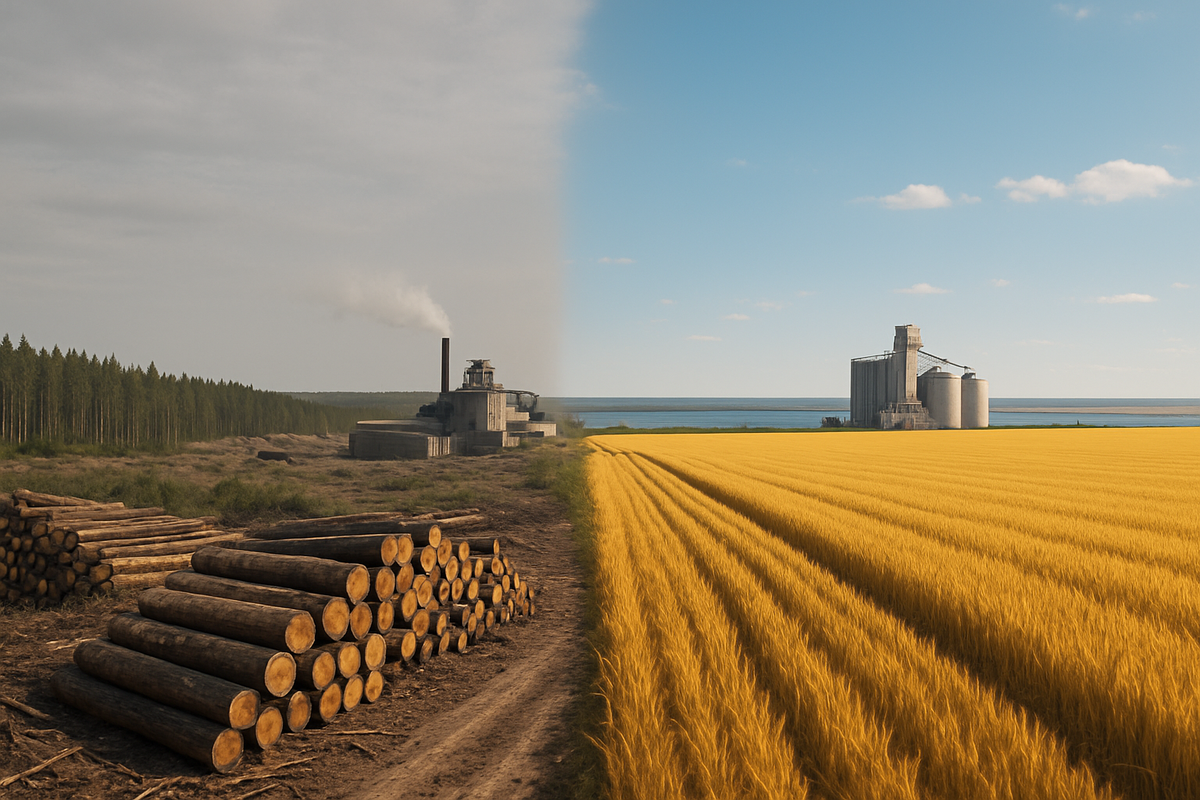
The S&P 500 Basic Materials sector, often a bellwether for global economic health, is currently showcasing a tale of two distinct trajectories, as evidenced by the contrasting performances of West Fraser Timber Co. Ltd. (NYSE: WFG) and Bunge Global SA (NYSE: BG). While the sector as a whole navigates a complex landscape of geopolitical tensions, fluctuating commodity prices, and the accelerating energy transition, individual companies are experiencing vastly different immediate realities. West Fraser Timber is contending with significant demand softness in the wood products market, leading to a cautious outlook and upcoming critical earnings report. In stark contrast, Bunge Global SA is riding a wave of positive momentum, fueled by a transformative merger and favorable shifts in agricultural commodity markets and trade policy, positioning it as a leading gainer within the S&P 500.
This divergence underscores the inherent sub-sector specific risks and opportunities within the broader Basic Materials index. As of October 15, 2025, while the overall materials sector has seen a mixed performance, with some daily dips but a robust year-to-date gain of nearly 19%, the individual narratives of these key players highlight how macroeconomic forces and strategic corporate actions are shaping their immediate and long-term prospects. Investors are closely scrutinizing these developments to discern where value lies amidst the sector's dynamic environment.
Detailed Coverage of Key Developments
West Fraser Timber, a leading diversified wood products company, is currently facing significant headwinds. The company is poised to release its Q3 2025 earnings after market close on October 22, 2025, with analysts projecting an EPS in the range of -$0.76 to -$1.425 and revenue around $1.38 billion. This comes on the heels of a challenging Q2 2025, where West Fraser reported an operating loss of $45 million and diluted EPS of -$0.38, missing consensus estimates. The company has lowered its 2025 guidance for Spruce-Pine-Fir (SPF), Southern Yellow Pine (SYP), and North American Oriented Strand Board (OSB) shipments, attributing the adjustment to softer-than-expected demand. Despite these operational challenges, West Fraser maintains a strong balance sheet with $1.7 billion in available liquidity and a net cash balance of $310 million, and recently declared a quarterly dividend of US$0.32 per share, payable on October 14, 2025. The company is actively pursuing operational excellence, cost reduction through strategic capital investments, and portfolio optimization, including a partnership with Lake Babine Nation announced in July 2025 to strengthen British Columbia's forest sector. The ongoing preliminary U.S. softwood lumber duty rates for 2023, set at 26.05% for West Fraser, remain a factor, though this is the lowest in the Canadian industry. Market sentiment for WFG is largely bearish, with the stock trading near its 52-week low and analysts generally holding a "Hold" rating, with some recent price target cuts.
In stark contrast, Bunge Global SA, a global leader in agribusiness and food, has experienced a surge of positive movement in October 2025. The primary catalyst was the successful completion of its merger with Viterra Limited on July 2, 2025, followed by a strategic business restructuring. Crucially, Bunge updated its full-year 2025 adjusted earnings per share (EPS) guidance to $7.30 to $7.60, which was met with enthusiasm by investors as it implied significantly less dilution from the Viterra acquisition than initially feared. The issuance of approximately 65 million new shares for the acquisition resulted in only about 4% dilution at the midpoint, surprising the market positively and leading Bunge to be a top S&P 500 gainer on October 15, 2025. Starting with Q3 2025 results, Bunge will report through new segments: Soybean Processing and Refining, Softseed Processing and Refining, Other Oilseeds Processing and Refining, and Grain Merchandising and Milling, aimed at enhancing transparency.
Adding further tailwinds to Bunge's momentum is a recent development in U.S. trade policy. On October 14, 2025, former President Donald Trump threatened to impose restrictions on U.S. imports of cooking oil from China, citing an "Economically Hostile Act" by China for ceasing soybean purchases. This potential policy shift could significantly benefit domestic agricultural processors like Bunge by increasing demand for U.S.-produced soybean oil and boosting crushing activity within the United States. This political rhetoric, combined with the favorable merger outcome, paints a robust picture for Bunge's near-term performance.
Companies Poised to Win or Lose
The current dynamics within the Basic Materials sector present clear winners and losers. West Fraser Timber (NYSE: WFG), alongside other lumber and wood product manufacturers, is currently in the "lose" column due to the persistent weakness in new home construction and repair/remodeling markets, driven by high mortgage and interest rates. Competitors such as Weyerhaeuser Co. (NYSE: WY) and Canfor Corporation (TSX: CFP), while having their own specific market positions, are likely to face similar demand-side pressures in their wood products segments. Their ability to manage costs, optimize production, and potentially diversify revenue streams will be critical in this challenging environment. West Fraser's strong balance sheet provides a buffer, but sustained weak demand will continue to pressure profitability.
Conversely, Bunge Global SA (NYSE: BG) emerges as a significant winner from the recent developments. The successful Viterra merger, coupled with a better-than-expected earnings outlook, solidifies its position as a global agribusiness powerhouse. The potential U.S. trade policy shift regarding cooking oil imports could further amplify its gains by boosting domestic soybean processing demand. Other major agricultural processors and traders, such as Archer-Daniels-Midland Company (NYSE: ADM), could also benefit from increased domestic processing activity if the proposed trade restrictions materialize. However, the broader grain market faces challenges, with forecasts of record global wheat production and declining prices for major grains, which could impact the grain merchandising segments of these companies. The resilience of the fertilizer subsector, supported by strong agricultural demand, suggests that companies like Nutrien Ltd. (NYSE: NTR) might also continue to exhibit robust performance within the Basic Materials sector, representing another "winning" segment amidst the broader volatility.
Wider Significance and Industry Impact
These contrasting narratives within the Basic Materials sector highlight several broader industry trends and their profound implications. For West Fraser Timber, the struggles underscore the cyclical nature of the housing market and its direct impact on lumber and wood product demand. High interest rates continue to suppress new home construction and renovation activities, a trend that has persisted throughout 2025. This situation creates ripple effects across the construction supply chain, affecting not only timber companies but also manufacturers of building materials, hardware suppliers, and indirectly, even real estate developers. Regulatory factors, such as the U.S. softwood lumber duties, add another layer of complexity for Canadian producers, though West Fraser's comparatively lower rate offers a slight competitive advantage. Historically, periods of high interest rates have always correlated with downturns in the timber industry, making this a predictable, albeit painful, cycle.
Bunge's positive trajectory, on the other hand, reflects the robust and growing demand for oilseeds, particularly driven by the expanding biofuel sector. This trend aligns with the broader global push towards decarbonization and alternative energy sources, making agricultural commodities like soybean and canola oil critical "energy transition materials." The strategic consolidation seen in the Bunge-Viterra merger also points to an ongoing trend of market leaders seeking scale and efficiency to navigate volatile global supply chains and commodity markets. The potential U.S. trade policy intervention, threatening restrictions on Chinese cooking oil imports, could significantly reshape global agricultural trade flows. Such protectionist measures, while potentially boosting domestic processors like Bunge, could also lead to retaliatory actions from trading partners, impacting other agricultural exports or creating price volatility in international markets. This echoes historical trade disputes, where agricultural products often become leverage in broader geopolitical tensions, highlighting the intricate link between trade policy and commodity markets.
What Comes Next
In the short term, all eyes will be on West Fraser Timber's Q3 2025 earnings report on October 22. This report will provide crucial insights into whether the company's cost reduction efforts and portfolio optimization strategies are beginning to mitigate the impact of weak demand. Any signs of stabilization in the housing market or an improved outlook from management could provide a much-needed boost to investor confidence. For Bunge, the successful integration of Viterra and the performance of its newly structured business segments in the upcoming Q3 results will be key indicators of the merger's long-term value creation. The market will also closely monitor any concrete steps taken regarding the proposed U.S. cooking oil import restrictions, as this could significantly alter the competitive landscape for agricultural processors.
Looking further ahead, the long-term prospects for West Fraser Timber hinge on a sustained recovery in the global housing market and a potential easing of interest rates. The company's strategic shift towards lower-cost mills and operational efficiencies will be vital in ensuring resilience through future cycles. For Bunge, continued growth in the biofuel sector and the effective realization of synergies from the Viterra merger present significant long-term opportunities. The evolution of U.S.-China trade relations and global food security concerns will continue to shape the agricultural commodities market, potentially creating both opportunities and challenges for Bunge. Investors should also watch for further consolidation within the agribusiness sector as companies seek to gain scale and control over supply chains. The broader Basic Materials sector will likely continue its sub-sector divergence, with energy transition materials (e.g., lithium, copper, biofuels) attracting sustained investment, while traditional cyclical segments remain sensitive to macroeconomic shifts.
Comprehensive Wrap-Up
The S&P 500 Basic Materials sector in October 2025 is a microcosm of the broader market's complexities, characterized by starkly different fortunes for its constituent companies. The contrasting experiences of West Fraser Timber and Bunge Global SA underscore the critical importance of sub-sector specific analysis and understanding the interplay between macroeconomic forces, geopolitical developments, and individual corporate strategies. West Fraser's struggles with soft demand in the wood products market serve as a reminder of the cyclical nature of the construction industry and the impact of high interest rates. Its resilience will depend on effective cost management and a potential rebound in housing.
Conversely, Bunge's surge, driven by a strategic merger and favorable trade policy rhetoric, highlights the opportunities within the agricultural commodities space, particularly those linked to biofuel demand and domestic processing. This divergence suggests that while the overall Basic Materials sector may offer robust year-to-date returns, investors must be highly selective. Key takeaways include the increasing importance of companies aligned with the energy transition, the impact of trade policy on global commodity flows, and the benefits of strategic consolidation in volatile markets. Moving forward, investors should closely watch interest rate trajectories, global trade negotiations, and specific company earnings reports, particularly West Fraser's upcoming Q3 results, to gauge the sector's momentum and identify enduring value. The ability of companies to adapt to evolving market conditions and leverage strategic advantages will ultimately determine their lasting impact and success in this dynamic environment.
This content is intended for informational purposes only and is not financial advice





